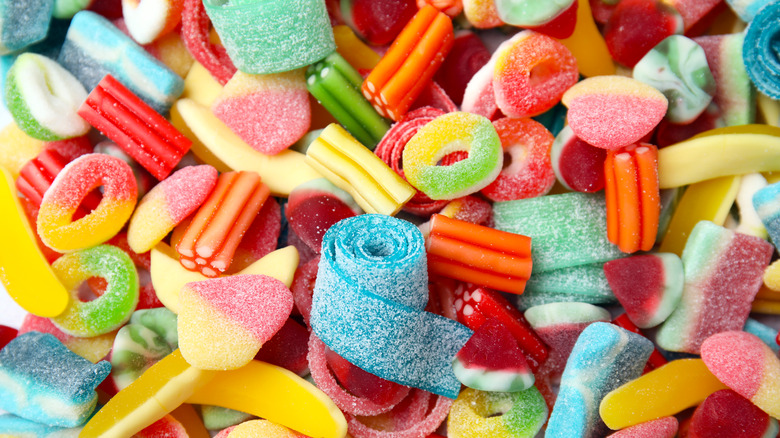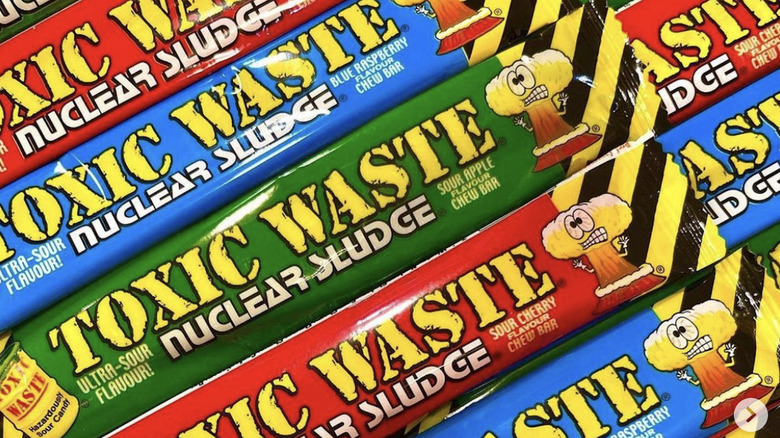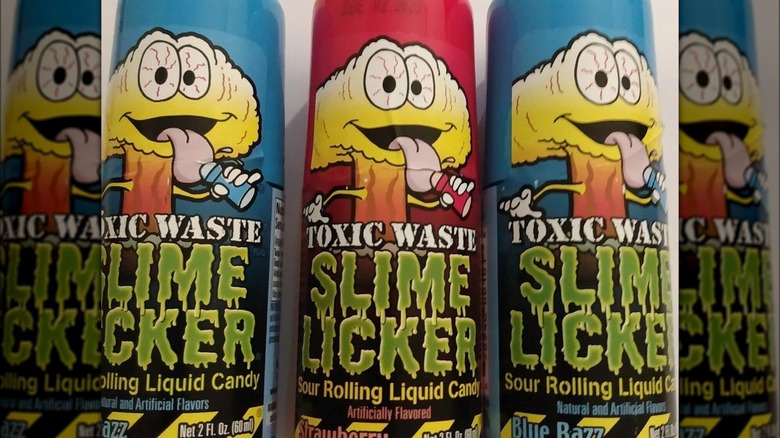The Discontinued Candy That Truly Embodied Its Off-Putting Name
The aggressive and bombastic confectionary niche of sour candy took off in the 1960s with the launch of Lemonheads. DareDevils and Warheads came along in the '80s and '90s and turned the sour candy market into a battlefield where producers differentiated its products by making them increasingly, unbelievably sour. In 2008, Toxic Waste Candy oozed onto the scene, with the "ultra-sour" treat including a brutal half-minute of mouth discomfort before the sweet sensation.
Distributor Candy Dynamics played up the so-called danger in Toxic Waste Candy, in various forms and serving sizes, by packaging it in containers that resembled atomic refuse receptacles. One of the more popular entries in the novel line, and perhaps among the best sour candies for many fans, was the Toxic Waste Nuclear Sludge Bar. Available in several flavors, the chewy candy arrived in a tiny yellow waste drum with green ooze painted on the lid.
However, in 2011, all flavors of Toxic Waste Nuclear Sludge were pulled from all stores across the U.S. In an ironic and horrifying twist, the candy with the jokey name alluding to dangerous materials was found to actually contain unacceptably high levels of a known toxin. The since discontinued candy really lived up to its "Toxic Waste" moniker.
Toxic Waste Nuclear Sludge contained a hazardous ingredient
Typically, what makes sour candy sour is the use of citric acid but that wasn't the issue here. In 2011, the California Department of Public Health conducted food safety testing on a batch of cherry-flavored Toxic Waste Nuclear Sludge Chew Bars and the results indicated a lead count of 0.24 parts per million. Lead is a heavy metal and exposure to and consumption of the material can lead to mental health issues, joint and muscle problems, and in pregnant women, miscarriage and premature labor. It can prove especially problematic and cause serious health problems for children.
The federal Food and Drug Administration allows for an upper limit of 0.1 lead parts per million in processed and packaged foods. This means that the cherry-flavored Toxic Waste Nuclear Sludge Chew Bars registered 24 times more lead than could be considered legally safe. Owing to what it said in a statement was "an abundance of caution," Candy Dynamics issued a voluntary recall of all flavors of Toxic Waste Nuclear Sludge bars, beyond just the cherry style, according to NPR.
The company also explained that the alarming oversight may have occurred because the Toxic Waste candy was produced in and imported from Pakistan, subject to different food safety standards than the U.S. Following the recall, the certifiably toxic chew bars didn't return to stores, joining the list of discontinued candies and gum we'll probably never see again.
Another Toxic Waste candy was recalled years later
Candy Dynamics survived the recall and so did the Toxic Waste umbrella of mouth-puckering candies. The company still markets "hazardously sour" treats in a number of formats and varieties, including Sour Smog Balls, and little waste drums stuffed with packets and pieces. In 2023, the company and the Toxic Waste brand faced another recall over claims that the mock-dangerous products could significantly harm consumers.
Candy Dynamics teamed with the Consumer Products Safety Commission to ask for the return of 70 million units of Toxic Waste Slime Licker Sour Rolling Liquid Candy. Sour sweets were delivered via a bottle outfitted with a roller, which had a tendency to separate from the unit during use, on which children could easily and feasibly choke. A seven-year-old girl's death was attributable to the faulty mechanism, leading to the recall.
"Candy Dynamics places the highest priority on the safety of our products," the company said in a statement on its website. "In light of that, we are recalling Slime Licker Sour Rolling Liquid Candy." While the recall wasn't due to nasty and harmful chemicals like the previous problem, it posed a threat to young consumers.


